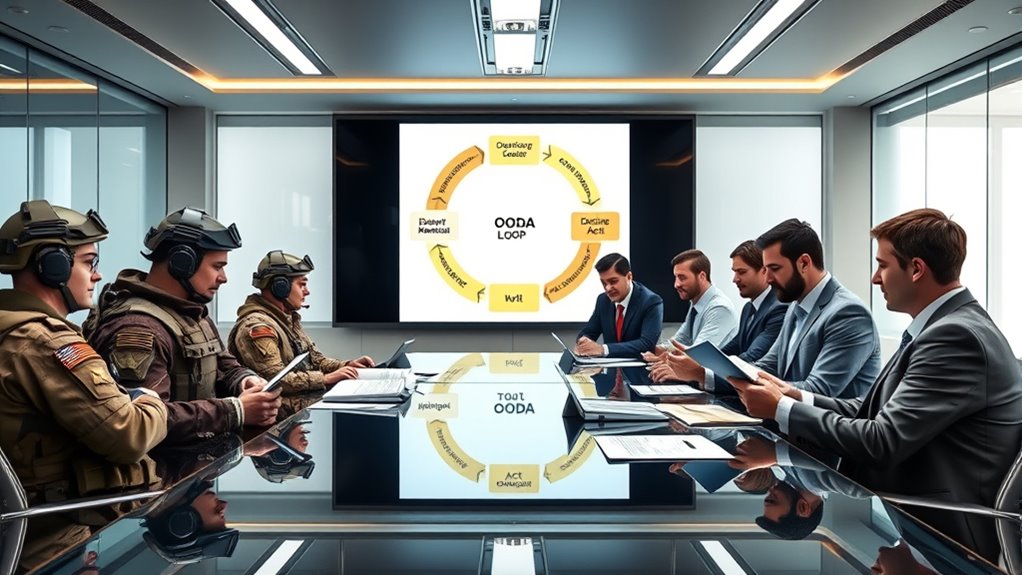The OODA Loop, created by Colonel John Boyd, blends military strategy with fast decision-making. It emphasizes observing your environment, orienting your understanding, deciding on a course, and acting quickly. This cycle helps you adapt rapidly to changing situations, gaining an advantage over opponents. Used beyond the battlefield, it improves business, cybersecurity, and crisis response. To learn how this simple yet powerful approach can transform your decisions, explore further insights ahead.
Key Takeaways
- The OODA Loop is a decision-making framework developed by Colonel John Boyd to enhance strategic agility in military contexts.
- It consists of four iterative stages: Observe, Orient, Decide, and Act, enabling rapid adaptation to changing environments.
- Originally inspired by Korean War air combat analysis, emphasizing decision speed over technological advantage.
- The model’s principles are applicable beyond military strategy, including business, cybersecurity, and emergency response.
- It promotes continuous feedback, situational awareness, and flexible mental models to outmaneuver opponents.
Origins and Evolution of the OODA Loop

Have you ever wondered how the OODA Loop came to be? It was developed by USAF Colonel John Boyd in the mid-1950s, inspired by analyzing air combat in the Korean War. Boyd studied why F-86 Sabre pilots had a 10:1 kill ratio over MiG-15 pilots, despite the MiG’s seemingly superior aircraft. He realized that quick, independent decision-making, not technology alone, made the difference. Boyd framed this process as a continuous cycle of Observe, Orient, Decide, and Act, emphasizing rapid adaptation and situational awareness. Initially, it focused on air-to-air combat but soon expanded to broader military strategies. Boyd’s interdisciplinary approach, drawing from science, physics, and philosophy, helped make the OODA Loop a versatile tool for gaining decision-making superiority. The concept of decision-making processes has since been adopted across various fields beyond the military. Furthermore, the integration of AI applications can enhance the speed and accuracy of each stage within the loop, transforming strategic decision-making in real time. As organizations increasingly adopt automation technologies, understanding how to optimize decision cycles becomes even more critical. Understanding these advanced techniques can provide a competitive edge in fast-paced environments. Additionally, ongoing research into neuroscience and cognitive science continues to deepen our understanding of rapid decision-making and perception, further enriching the effectiveness of the OODA Loop.
Core Elements of the Decision Cycle

Understanding the core elements of the OODA Loop is essential to mastering its decision-making power. This process is iterative, meaning you continuously update your decisions as new information arises. Faster cycles disrupt opponents’ thinking, giving you a strategic edge. Feedback plays a crucial role, allowing you to adapt swiftly to environmental changes. Prioritizing agility over raw power helps you respond more effectively in dynamic situations. During each cycle, you observe your surroundings, gather relevant data, and analyze it within the context of your mental models and situational awareness. You then decide on the best course of action and execute it quickly. This ongoing feedback loop enables continuous learning, fostering adaptability and refinement, which ultimately enhances your decision-making effectiveness and keeps you ahead in competitive environments. Incorporating situational awareness into each step ensures that your responses align with real-time conditions, amplifying the effectiveness of your decisions. Recognizing the importance of real-time information from your environment allows for quicker adjustments and more accurate assessments throughout the cycle. Developing mental models helps streamline your decision process, making your responses more intuitive and effective. Additionally, understanding the significance of feedback mechanisms can help you identify areas for improvement and refine your strategies more efficiently. Building a strong foundation in natural elements can also enhance your ability to stay calm and focused during rapid decision cycles.
Applications Beyond the Battlefield

How can the OODA Loop enhance decision-making across diverse fields beyond the battlefield? In business, it enables you to adapt quickly to market shifts and competitor moves, improving situational awareness and operational speed. For cybersecurity, it structures rapid responses to threats, allowing real-time adjustments and coordinated actions. In emergency management, it streamlines decision processes during crises, helping teams assess situations swiftly and prioritize actions effectively. Law enforcement benefits from the loop by making fast, informed decisions in high-pressure situations, improving safety and tactical outcomes. Even in sports, athletes and coaches use it to observe, react, and adjust tactics rapidly in competitive environments. Applying the OODA Loop across these fields keeps you agile, informed, and ready to adapt—key to staying ahead in dynamic scenarios. Additionally, understanding the key traits of successful quality assurance engineers can support effective implementation of these decision-making strategies.
Strategic Benefits of Using the OODA Loop

What makes the OODA Loop a powerful tool for strategic advantage is its ability to speed up decision-making and improve response times. By breaking decisions into Observe, Orient, Decide, and Act phases, you process information efficiently and respond quickly to changing situations. This rapid cycle enhances your competitiveness, letting you react faster than opponents or market shifts. The continuous iteration allows real-time adjustments, preventing stagnation and increasing resilience. It also sharpens your situational awareness by constantly analyzing data, helping you stay adaptable to disruptions or unexpected events. Additionally, the structured framework reduces ambiguity, guiding disciplined decision-making even with incomplete data. Incorporating cost considerations into the OODA Loop can further optimize resource allocation and planning. Recognizing information processing as a core component emphasizes the importance of rapid data analysis for effective decision-making. Emphasizing rapid feedback mechanisms can further refine your responses and improve overall effectiveness. Furthermore, integrating personality insights can enhance team dynamics and decision cohesion. Ultimately, the OODA Loop grants you a cognitive edge, enabling faster, smarter responses that secure operational superiority and long-term strategic success.
Comparing the OODA Loop to Other Decision Models

When comparing the OODA Loop to other decision models, its unique emphasis on rapid iteration and continuous adaptation sets it apart. Unlike static models, OODA highlights feedback loops and the importance of quick, ongoing reassessment, especially through its Orientation phase. While Recognition-Primed Decision models rely on pattern recognition, OODA incorporates broader situational awareness, enabling faster responses. Its feedback cycles help disrupt opponents’ decision-making by cycling through information more effectively. Compared to structured methods like MDMP, which follow linear steps, OODA favors speed and flexibility, especially in dynamic environments. Its focus on updating perceptions and mental models continuously allows you to adapt on the fly, making it a powerful tool in fast-changing scenarios, where staying ahead depends on rapid decision cycles. Additionally, understanding cookie management and privacy considerations can enhance our strategic approach by ensuring ethical data use and maintaining trust during decision implementation. Furthermore, integrating ethical hacking principles can help anticipate potential vulnerabilities in decision processes, strengthening overall strategic resilience. Recognizing the importance of environmental considerations can also improve decision-making by promoting sustainable and responsible actions in complex scenarios. Moreover, incorporating awareness of AI vulnerabilities can help preempt exploitation and ensure more secure decision frameworks. Staying aware of feedback mechanisms within the decision process can further refine your ability to adapt effectively.
Influences and Broader Impact on Strategy

The strategic influence of the OODA Loop extends far beyond its military origins, shaping decision-making frameworks across various domains. You’ll find it integral to business strategies that prioritize agility, enabling organizations to respond quickly to volatility and uncertainty. Start-ups adopt rapid prototyping and iterative decision cycles, echoing Boyd’s emphasis on acting fast. In cybersecurity and disaster response, real-time situational assessment and adaptive actions are essential, often employing AI systems that emulate OODA processes. The model also influences diplomatic negotiations, where rapid recalibration becomes vital. Beyond organizational tactics, the OODA Loop’s principles promote decentralized command, empowering individuals and teams to make autonomous decisions. This broad impact fosters a culture of continuous feedback, risk management, and strategic agility in both military and civilian sectors.
Frequently Asked Questions
How Can Individuals Apply the OODA Loop in Personal Decision-Making?
You can apply the OODA loop in personal decision-making by actively observing your environment and gathering relevant facts, filtering out distractions. Use your experiences to develop mental models that help interpret data accurately. Generate multiple options, evaluate their potential outcomes, and make flexible decisions. Act decisively, then monitor results closely. Learn from each cycle to improve your understanding, adapt to changes, and make smarter choices efficiently.
What Are Common Challenges in Implementing the OODA Loop Effectively?
Imagine trying to steer a boat through foggy waters—you need quick, clear decisions. You might face resistance from old habits, misinterpret data, or wait for feedback. Organizational structures, technology limits, and fear of risk can slow you down. These challenges block your ability to observe, orient, decide, and act swiftly. Overcoming these hurdles requires openness, communication, and adapting your mindset to keep moving forward effectively.
Can the OODA Loop Be Integrated With Other Strategic Frameworks?
You can definitely integrate the OODA Loop with other strategic frameworks. Doing so lets you adapt your decision-making process to different environments, improve assessment accuracy, and stay agile. For example, combining it with SWOT analysis enhances risk evaluation, while merging it with Agile speeds up product development. Just remember, blending frameworks increases complexity, so you need to manage resources carefully and guarantee your organization remains flexible for smooth implementation.
How Does Technology Enhance the Speed of the OODA Cycle?
Technology enhances the speed of your decision cycle by streamlining observation, accelerating orientation, expediting decision-making, and enabling rapid action. You harness AI for real-time data analysis and predictive insights, deploy advanced ISR systems and sensors for quicker observation, utilize automation and autonomous systems for faster responses, and leverage enhanced communication networks for swift coordination. Together, these innovations reduce delays, improve accuracy, and allow you to adapt swiftly in dynamic environments.
What Are Examples of Successful OODA Loop Applications in Business?
You can see successful OODA Loop applications in business through companies like Google, Facebook, and Amazon, which rapidly adapt their algorithms based on market data. They observe customer behavior, orient quickly to new information, decide on adjustments, and act fast. This cycle helps them stay ahead in competitive markets. Similarly, e-commerce businesses use it for inventory, website performance, and marketing, improving efficiency and responsiveness in real time.
Conclusion
By mastering the OODA loop, you gain a strategic edge—studies show that teams practicing rapid decision cycles can outperform slower competitors by up to 50%. This underscores how agility and adaptability aren’t just military tactics but essential skills in today’s fast-paced world. Embrace the OODA loop to stay ahead, make smarter decisions quicker, and turn uncertainty into your advantage. Ultimately, your ability to observe, orient, decide, and act defines your success.









